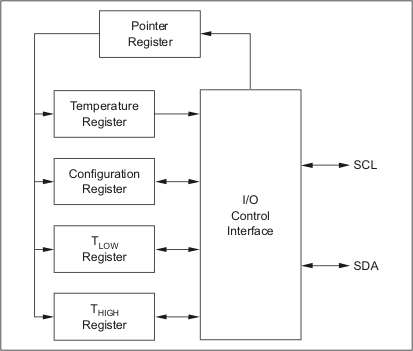SBOS363F June 2006 – May 2018 TMP275
PRODUCTION DATA.
- 1 Features
- 2 Applications
- 3 Description
- 4 Revision History
- 5 Pin Configuration and Functions
- 6 Specifications
-
7 Detailed Description
- 7.1 Overview
- 7.2 Functional Block Diagram
- 7.3 Feature Description
- 7.4 Device Functional Modes
- 7.5 Programming
- 8 Application and Implementation
- 9 Power Supply Recommendations
- 10Layout
- 11Device and Documentation Support
- 12Mechanical, Packaging, and Orderable Information
Package Options
Mechanical Data (Package|Pins)
Thermal pad, mechanical data (Package|Pins)
Orderable Information
7.5.1 Pointer Register
Figure 11 shows the internal register structure of the TMP275. The 8-bit Pointer Register of the devices is used to address a given data register. The Pointer Register uses the two LSBs to identify which of the data registers should respond to a read or write command. Figure 12 identifies the bits of the Pointer Register byte. Table 3 describes the pointer address of the registers available in the TMP275. Power-up reset value of P1/P0 is 00.
 Figure 11. Internal Register Structure of the TMP275
Figure 11. Internal Register Structure of the TMP275